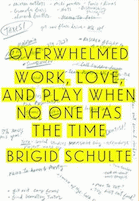This is the conclusion of my interview with Brigid Schulte, Pulitzer Prize-winning journalist for the Washington Post and author of of the New York Times bestseller, Overwhelmed: How to Work, Love and Play When No One Has the Time (Farrar, Straus and Giroux, 2014; Picador paperback edition, 2015). [Part one]
JB: When we broke, Brigid, we were talking about Denmark and their family-friendly policies. What fascinated me is that Denmark has not always been so progressive in gender equality issues. In fact, their turnabout has taken place in a relatively short time. Can you explain why they as a nation changed and how they did it?
BS: The New America Foundation, the non-partisan, non-profit think tank where I've been a fellow, had a great event with the Consul General in New York, Ambassador Jarl Frijs-Madsen and me, talking about the two cultures and work, love and play.
He said, and the history shows, that at one time, Denmark was much more traditional in its gender roles, and also more work-focused, much like the United States. Indeed, when I was researching the book, what struck me was how the United States really led the world in the 1930s when it came to humane and sane lives for workers - the Fair Labor Standards Act of 1930 shortened work hours to 40, ensured overtime pay for hourly workers to try to enforce those more liveable hours, and mandated a minimum fair wage. Proponents also pushed for paid vacation, but failed. At that time, European countries worked much longer hours. American workers and unions sang about having time for bread, for the work they needed to provide it at a fair wage, but also having time for roses, to enjoy their lives.
We marveled at how roles have really changed in recent decades. The United States hasn't made much appreciable change to its workplace laws since 1938. And over the years, European countries have made big changes - The European Work Time Directive limits work hours. Countries like Denmark have paid sick days, paid parental leave and long paid vacation policies - the U.S., along among the advanced economies, has none of those policies.
But what's interesting about Denmark is that, in the 1970s, when mothers began entering the workforce across the globe - because the women's movement opened doors, and because wages began to stagnate in the U.S. (and have been stagnating ever since) and two incomes were needed to provide the standard of living that one had been able to - and in the Scandinavian countries, labor shortages and cultures that haven't historically been open to immigration, governments designed policies meant to encourage mothers to work. That's one of the biggest differences, I think - the U.S. is still very ambivalent about whether mothers should work - that shows up in surveys done by the Pew Research Center and also the General Social Survey. And if we're not sure that we want mothers to work outside the home, why would we pass policies to help they and their families better manage?
In the meantime, Scandinavian countries passed laws in the 1970s giving generous maternity leave, and other sort of "mommy centric" policies. Then, about 10 years ago, they began realizing that though they'd made it easier for mothers to work, they'd inadvertently stacked the deck against them. Long maternity leaves meant many employers didn't want to hire women. So many wound up in public sector jobs, or working part-time. There's greater occupational segregation in Sweden, for instance, than in the U.S.

'Overwhelmed' cover art
(Image by design by Rodrigo Corral, Picador; Farrar, Straus and Giroux) Details DMCA
JB: How did they counteract the inadvertent imbalance that was created from legitimately supportive policies?
BS: So these countries began rethinking their policies - thinking more about supporting women AND men, whole families, if you will. They began to realize that you can't really even the playing field for women in the workplace without evening the playing field on the homefront. So they began devising policies and running information campaigns designed to encourage fathers to take equal paternity leaves - to give mothers AND fathers nurture days with their children. To promote gender equity in politics, in business, on public and private boards and commissions, etc.
The family I spent time with in Copenhagen and write about in the book were pretty typical. They'd BOTH taken solo parental leave. And it was so interesting to see how this changed the dynamic of the family. They switched off working long and short days - and the one working the short day was responsible for the child care pick up (at 3:30!! - in Denmark the "iffy" parents are those who swoop in at 4:30! I almost cried. I remember when I had to hire a separate babysitter for a 6 pm child care pick up because of my long, traffic-clogged commute and late newspaper deadlines. I hated that.).
One of the things that I find most hopeful is that in the countries where it is becoming "normal" for fathers to take solo parental leave - studies are finding that three years later, the majority of couples are equally sharing child care duties. Mental and physical duties. Planning and caring. Mom is no longer the "default" parent in charge, doing all the drudgery and time-sensitive work (Get in the car NOW! Oy - that was me when my kids were little....) and Dad is no longer the "helper" doing all the fun stuff. And with more equity -more humanness at home, there's more equity at work. And the changed family dynamics mean that moms aren't stressed and rushed and resentful all the time (at least I was) for doing it all, that fathers feel that they're more than a distant breadwinner and really intimately involved with their families, the couples' relationship are better, kids have close relationships to both parents, and there's more time for everyone - particularly mothers.

Brigid and husband Tom Bowman on spontaneous cross country ski outing, January 2015
(Image by courtesy of Brigid Schulte) Details DMCA
JB: You mention how important paternity leave is. I agree. But, even if new parents want a more equitable distribution of labor between themselves, how do we get businesses to let go of the Ideal Worker trap that makes it so much more difficult and complicated? You did find some encouraging signs in various individual businesses. Tell us more, please.
BS: I did! I went searching for Bright Spots - in research and in real life, and I found them. Right now, the drive for overwork and equating long hours, rather than performance, with high productivity and commitment, is pretty rampant in most companies. That was only exacerbated in the economic downturn of 2008 and continuing economic uncertainty. Many people feel lucky to have jobs and are anxious to prove they're worth keeping - even if that means staying late and answering emails late into the night.
What I find really interesting, however, are the companies that are using the latest scientific research from neuroscience and human motivation to set up a very different kind of workplace and work experience.
(Note: You can view every article as one long page if you sign up as an Advocate Member, or higher).






